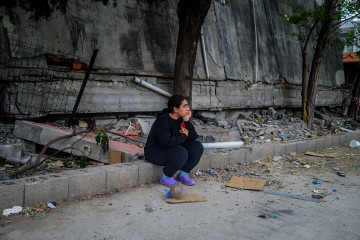

More than one hundred days after the deadliest earthquakes in Turkey and Syria's recent history, millions of children and families are struggling to rebuild their lives, with 2.5 million children in Turkey and 3.7 million in Syria in need of continued humanitarian assistance.
The two initial devastating earthquakes on 6 February 2023, followed by thousands of aftershocks, have pushed many families to the brink and left children homeless and without access to essential services, including safe water, education and medical care, and increased protection risks for vulnerable children.
"The earthquakes struck areas where many families were already incredibly vulnerable. Children have lost family and loved ones, and seen their homes, schools and communities devastated and their entire lives turned upside down”
“In the aftermath of the earthquakes, children in both countries have experienced unimaginable loss and grief,” said UNICEF Executive Director Catherine Russell, who visited both countries just weeks after the initial earthquakes.
“The earthquakes struck areas where many families were already incredibly vulnerable. Children have lost family and loved ones, and seen their homes, schools and communities devastated and their entire lives turned upside down.”
Even before the recent earthquakes, many families in affected areas were struggling. In the regions of Turkey, rates of poverty among children were already high – with approximately 40 percent of households living below the poverty line, compared to around 32 percent seen nationwide.
Estimates show that without sustained local and international support, including cash transfers and ensuring access to education, this figure could rise to more than 50 percent.
At present, vulnerable children in hard-hit areas are exposed to threats including violence, forced marriage or labour, and dropping out of school.
"An estimated 51,000 children under the age of five are likely to suffer from moderate and severe acute malnutrition and 76,000 pregnant and breastfeeding women need treatment for acute malnutrition"
The education of nearly four million school-enrolled children was disrupted, including more than 350,000 refugee and migrant children.
While Turkey has made progress in reducing these risks in recent years, the impact of the earthquakes could set that work back.
In Syria, children were already struggling after 12 years of sustained conflict, which has had an impact on all infrastructure and public services. The massive tremors in February exacerbated this, causing further damage to schools, healthcare, and other essential infrastructure.
The severe damage to water and sewage infrastructure has put 6.5 million people at an elevated risk of waterborne diseases, including cholera.
An estimated 51,000 children under the age of five are likely to suffer from moderate and severe acute malnutrition and 76,000 pregnant and breastfeeding women need treatment for acute malnutrition.
An estimated 1.9 million children have had their education disrupted, with many schools still being used as shelters. Throughout the last 100 days, many of them are still living in incredibly difficult situations, with stress heightened by the additional uncertainty of not knowing when they need to move from one shelter to another.
|
“The road to recovery is a long one, and families will require our continued support,” said Russell. “The long-term impacts of the disaster, including soaring food and energy prices combined with the loss of livelihoods and access to services will push hundreds of thousands of children deeper into poverty.
"Unless financial assistance and essential services are prioritised for these children and families as part of the immediate and long-term recovery plan, then children will remain at greater risk of exploitation and abuse.”




 Follow the Middle East's top stories in English at The New Arab on Google News
Follow the Middle East's top stories in English at The New Arab on Google News


